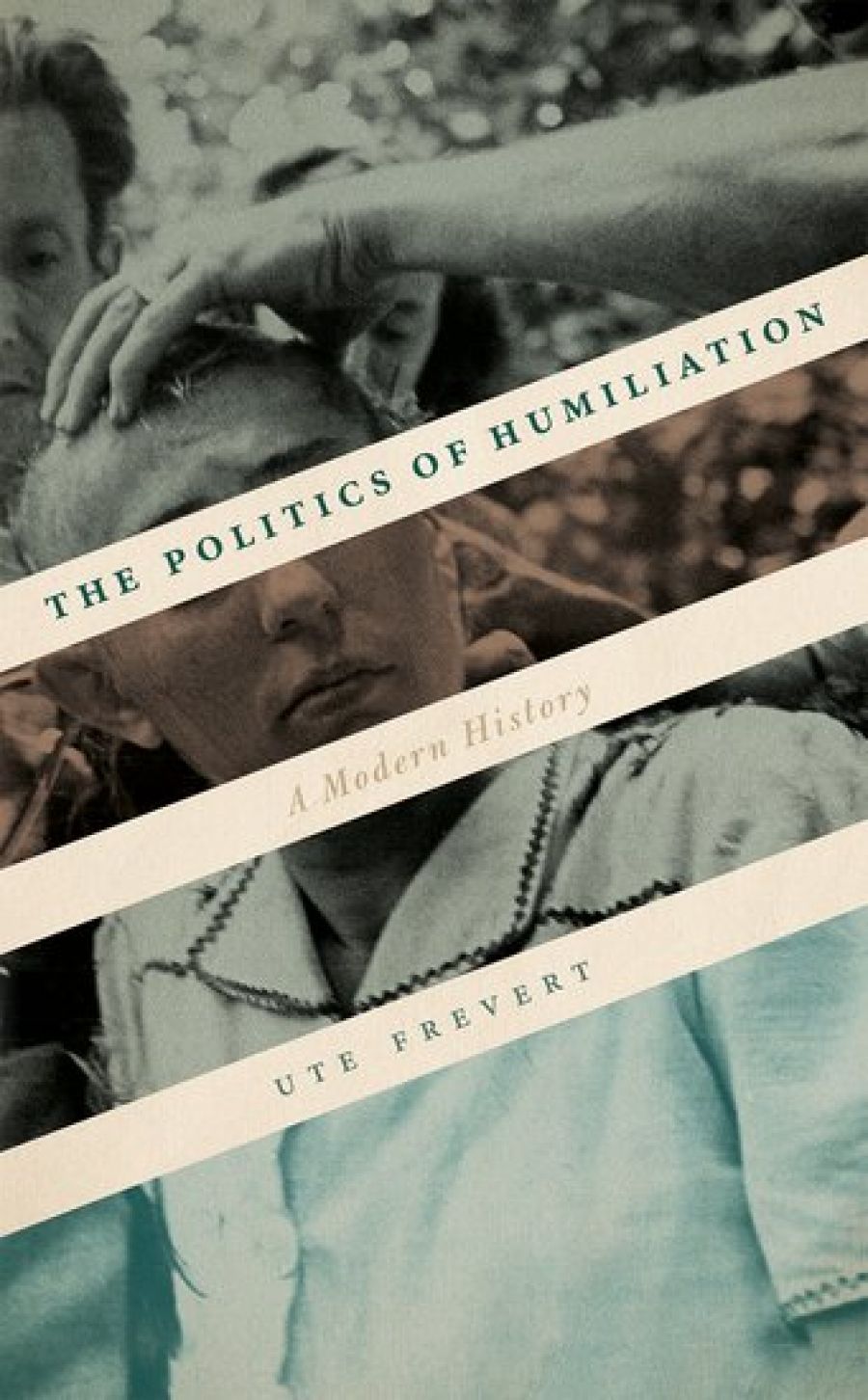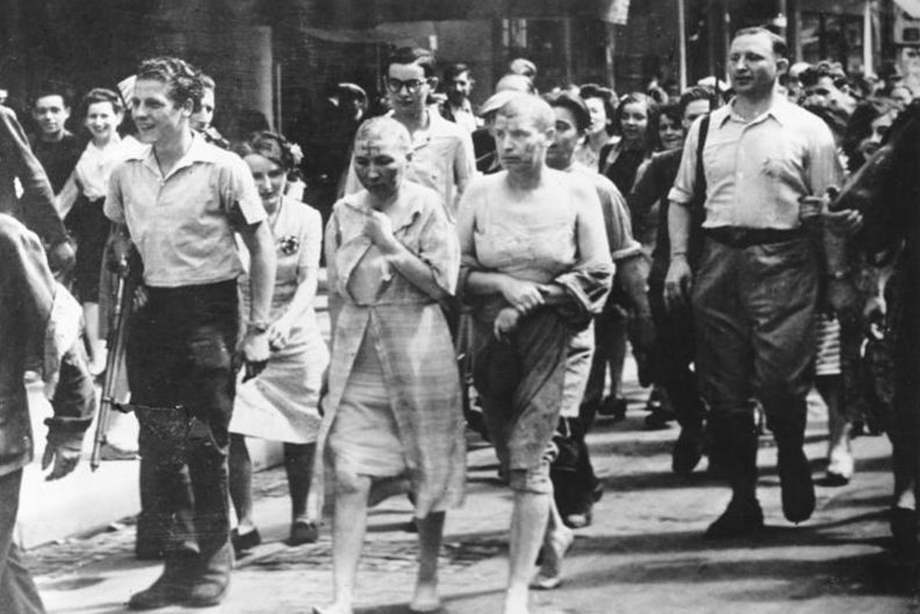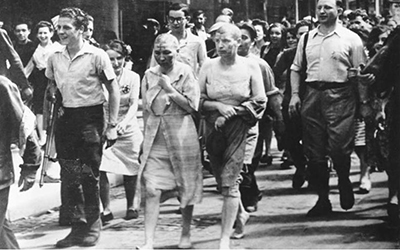
- Free Article: No
- Contents Category: History
- Review Article: Yes
- Article Title: The new pillory
- Article Subtitle: Shame and humiliation in history
- Online Only: No
- Custom Highlight Text:
As I started to read this book, right-wing extremists stormed the US Congress, spurred on by a president who was unable to accept defeat at the ballot box. It has long been recognised that Donald Trump is a narcissist, but, as Ute Frevert aptly points out in The Politics of Humiliation, narcissism and shame are closely related. Trump feels humiliated by his defeat and is therefore psychologically incapable of accepting his loss, on any level. But there is another side to Trump’s behaviour: he has been quite ‘shameless’ in the way he bends truth and humiliates other political leaders.
- Article Hero Image (920px wide):

- Article Hero Image Caption: French women accused of collaboration are paraded through the streets of Paris (German Federal Archives via Wikimedia Commons)
- Featured Image (400px * 250px):

- Alt Tag (Featured Image): French women accused of collaboration are paraded through the streets of Paris (German Federal Archives via Wikimedia Commons)
- Book 1 Title: The Politics of Humiliation
- Book 1 Subtitle: A modern history
- Book 1 Biblio: Oxford University Press, £25.00 hb, 352 pp
- Book 1 Readings Link: booktopia.kh4ffx.net/4eBMXn
Ute Frevert, a German historian, is director of the Center for the History of Emotions in Berlin. In this new book, she offers an overview of the uses of public humiliation over the past two hundred years. A large part of it focuses on German history, but there are plenty of examples from other countries. At its heart is a desire to understand why people feel the need to humiliate others in public, even one’s own children. One of the stories Frevert begins with is that of the thirteen-year-old Izabel Laxmana, who committed suicide after her father posted a video of him cutting off her hair, punishment for posting too many selfies. It might seem trivial, but it was a humiliation she did not want to live with.
Frevert examines three broad categories of shaming and public humiliation: pillorying and public beatings within legal and judicial frameworks; sites of public shaming from the classroom to online bullying; and the idea of humiliation in international relations. The first part of the book is a tale readers will be familiar with: the use of the pillory and corporal punishment in Europe to punish petty crimes. Shame and humiliation are two sides of the same coin, but humiliation, to be felt, must be public; it must be done in the presence of other people who witness the individual’s shame and embarrassment. Eventually, those kinds of public punishments disappeared, contested by the rise of ideas around human dignity and by changing notions of honour.
Educators, however, took much longer to change their minds about corporal punishment. In the nineteenth century, German, American, and English advice manuals for mothers instructed them to teach their children to feel ashamed. It had to be developed over time and carefully cultivated. Manuals also talked about the use of physical violence, especially for boys, as part of the education process. A caning in front of the classroom was meant to bring with it humiliation and shame. This kind of punishment was questioned, but only in so far as some believed the punishment should be private and not made public.
Public shaming had many forms. The Nazis used public humiliation as a tool in their construction of a racially defined community (Volksgemeinschaft). As early as 1935, Brownshirts in the city of Breslau conducted so-called pillory parades through the streets against couples deemed ‘racially defiled’, often accompanied by marching bands and large crowds. There always seemed to be hundreds of people willing to take part in this shaming ceremony, following the person or couple, insulting or jibing them along the way. Clearly, some Germans enjoyed the spectacle, revelling in the crude humiliation of a targeted group of people.
For a short period during the war, German women who slept with ‘foreign men’ – French prisoners of war set to work on farms, or Polish or Russian forced labourers – were publicly humiliated by having their heads shaved and then paraded through the streets so that people could express their disgust. In this instance, the practice was stopped in the face of widespread criticism. Even the Nazis responded to public opinion. Nazi Germany was not the only country to conflate national honour with women’s bodies. In France, after the liberation, women who had slept with Germans were often publicly shamed by having their heads shaved. It was a case of men taking revenge on women who slept with the enemy, but women took part too, often gleefully, as can be seen in the photographic evidence from the period.
One would think that this kind of public shaming was well and truly in the past, but, as Frevert shows, it has simply morphed into other forms. The media has increasingly taken on the role of a ‘social pillory’, as she calls it, and has sometimes brought down high-profile politicians in the process. Think of the 1988 Democratic presidential candidate Gary Hart, obliged to drop out of the race amid revelations of extramarital affairs. Closer to home, the New South Wales Minister for Transport, David Campbell, filmed leaving a gay sex club in Sydney, was then shamed into resigning from politics. Public figures have always been the target of disapproval, but the power to degrade others has increased exponentially through the media and social media, as has the audience willing to watch. This is the opposite of a society that values non-violent communication, respect, and human dignity.
Shame and embarrassment can also apply to foreign relations. The current relations between China and Australia are an interesting case in point. China’s humiliation at the hands of the West and Japan in the nineteenth and early twentieth century makes up a good part of chapter three. The period between the First Opium War in 1839 and the communist takeover in 1949 is still known in China as the ‘century of humiliation’. It puts a slightly different slant on the claim by China’s deputy head of mission to Australia, Wang Xining, that his country’s feelings were hurt after Australia announced that it would lobby for an independent inquiry into the origins of Covid-19. It’s true that China likes to play the victim of past aggressions to bolster contemporary political agendas, but given their treatment at the hands of European colonial powers, their sensitivity can perhaps better be placed in context.
What Frevert so eloquently demonstrates in this well-written book is that shaming and humiliation have played a central role in the history of the modern world, the impact of which was really only moderated, often with great resistance, in the latter part of the twentieth century. But if the state stopped using shaming as a punitive strategy, private individuals today merrily resort to it when individuals or groups are targeted and singled out for humiliation. The state is now meant to protect its citizens from public humiliation, but, as in many domains associated with electronic media, it has failed to catch up. The pillory has not really left us; it’s just taken on another form. In the modern world, Frevert argues, demeaning images posted on social media ‘now stick to victims (and perpetrators) like feathers on tar’. They have long-term and lasting consequences. In some respects, they are worse than the pillory, or tarring and feathering, because the images stay on the internet forever and can reach a worldwide audience. Ultimately, as Frevert points out, the politics of humiliation depends on a public staging and on an audience that is willing to watch and applaud. In liberal democratic nations, citizens demand respect from one another, but it is still obviously not always forthcoming.


Comments powered by CComment